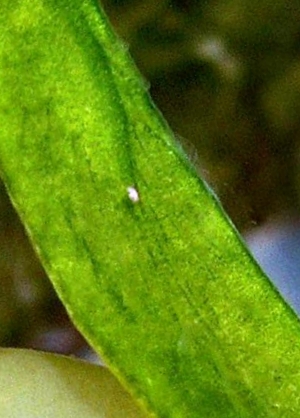First Bosellia from Australia
August 15, 2006
From: Denis Riek

Dear Bill,
Here are some shots of Bosellia sp. 1? from northern New South Wales. It was found on Halimeda weed just below low tide mark on rock reef. At 6 mm this is the largest animal I have found, previous ones were very small and nearly overlooked due to their resemblance to flatworms. It has a white spot and shallow grooves on the dorsum as in the animal shown in Jun Imamoto's message. It also has what appears to be some form of discharge(?) over the dorsum. Any ideas as to what this is?
Locality: Hastings Point, northern New South Wales, 1 metre, Australia, Pacific, 17 December 2005, On Halimeda, subtidal rock reef. Length: 6 mm. Photographer: Denis Riek.
Regards
Denis
dwriek@optusnet.com



Dear Denis,
This is indeed an interesting find. It is the first record of the genus from Australia, or anywhere in the south Pacific, and certainly looks the same as the animal from Japan and Hawaii which are on the Forum as Bosellia sp. 1. Two quite distinctive features seem to be the white (sometimes pinkish) spot in the middle of the back, and the strangely shaped rhinophores, with the rounded green basal half and the upper, thin, almost translucent, brownish. Looking at your photos, the brown colouration stops below the tip of the rhinophore giving it a translucent margin, which in some cases seems to have whitish glands forming a band. In a couple of photos [see inset alongside] there are also traces of a whitish band at the base of the upper thin half of the rhinophore as well.
Looking at the colour of the rhinophore in this detail may seem a bit fanatical, but Eveline Marcus (1978) described a species, Bosellia cohellia, and its only real distinguishing feature is the rhinophore colour:
'they have pinkish tips and two broad chalk white bands, the three interrupted by two stripes of the green ground colour' .
I am afraid this is another species description which should probably have been left unpublished. It was based on one photographic colour slide, and serial sections of one specimen sent to her by Tom Thompson, who was not sure if the specimen was from the Mediterranean or the Red Sea! When I look at other photos of Bosellia sp. 1, it is not unreasonable to fit her colour description of the rhinophores to some of these specimens. I guess what we need to do now is hope that someone will look carefully at Halimeda in the Red Sea and see if this animal can be found there.
Concerning the 'discharge' you mentioned. I have included a couple of close-ups from your photos you show there is a secretion being given off by the skin. Most sacoglossans produce mucous secretions from glands in their skin, which are presumed to be defensive. They are often milky white. I guess that is what we can see here. Another thing that would be interesting to find out is what its egg mass looks like. In shape it should probably look like that of Thuridilla neona [message # 9719 ], but not necessarily that colour. It will probably have large blobs of extra yolk as in Thuridilla, and I would expect the eggs to be deposited on Halimeda.
-
Marcus, Ev. (1978) On a new species of Bosellia. Boletim de Zoologia da Universidade de Sao Paulo, 3: 1-6.
Best wishes,
Bill Rudman
Related messages
-
Bosellia sp. 1 from Okinawa
From: Bob Bolland, March 5, 2004 -
Re: Bosellia mimetica? from Japan.
From: Jun Imamoto, March 3, 2004 -
Re: Bosellia from Japan
From: Cory Pittman, March 2, 2004 -
Re: Bosellia mimetica? from Japan.
From: Jun Imamoto, March 2, 2004 -
Re: Bosellia from Japan
From: Bill Rudman, March 2, 2004 -
Bosellia mimetica? from Japan.
From: Jun Imamoto, March 1, 2004 -
Re: Bosellia from Japan
From: Kathe Jensen, March 1, 2004
